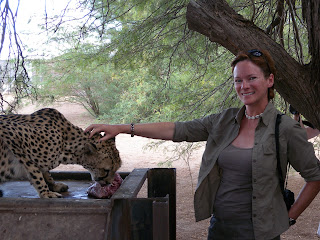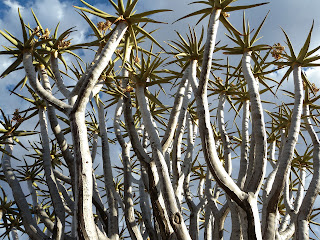From the Brandberg mountain, we headed to Swakopmund on the coast. This is Namibia's premier seaside resort and quite an affluent place. The German influence is palpable in terms of the architecture and number of cafés that serve an assortment of enticing cakes. I decided that it would be a good place to return to and hang out in for the last few days of my trip.
From Swakopmund, we returned to Windhoek and spent one night there before heading on the southern circuit of the tour. There is one major highway - the B1- that cuts right through the middle of Namibia from north to south. It is straight for as far as the eye can see. It only has one lane running in each direction, but given the density of population in Namibia, traffic jams are not exactly an issue. Indeed, Namibia must be a civil engineer's dream with its vast open plains. It's not unusual to see a railway line, electricity pylons and water pipes running alongside a road as there is enough flat land to build all the infrastructure in close proximity and no buildings to bypass.
As we headed south, there was a noticeable rise in temperature. Our route took us through a strip of the Kalahari desert and we stopped to take photographic evidence as we passed the Tropic of Capricorn. There are no service stations along the highway, but concrete tables and stools where you can stop and eat lunch. Passing other drivers is a relatively rare occurrence, so they tend to put a hand up to acknowledge each other on route - almost with a sense of camaraderie that you've both ventured into the middle of nowhere.
 |
| Crossing the line.. |
 |
| Our lunch spot in the wilderness |
 |
| Rush hour on the B1 highway |
Our first destination in the south was the Quiver tree forest, just north of Keetmanshoop. When we arrived at the campsite, we were taken by the owners to see their cheetahs and observe them at feeding time. In Namibia, people seem to keep cheetahs like other people keep dogs, since they are easily tamed and relatively timid. The legal requirement is that you have to keep them in no less than one hectare of land. One of the female cheetahs was so tame that she even allowed us to stroke her head even while eating.
 |
| Funky accommodation at the campsite |
After setting up camp, we went to see the quiver trees themselves. Quiver trees are a form of aloe and the early San people used to cut their branches and hollow them out to make a quiver or holder for their arrows. The land where our campsite is based has the largest concentration of quiver trees in Namibia. They look surreal and almost Gaudi-esque in appearance. And I can imagine that he would have been wonderfully inspired by them.














No comments:
Post a Comment